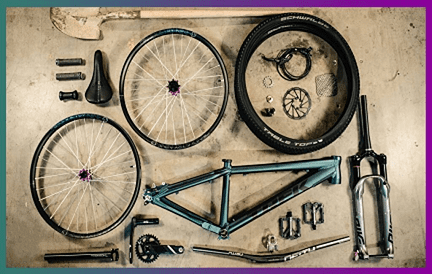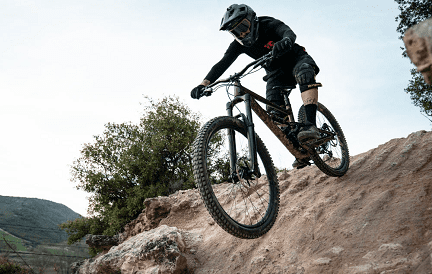Mountain bikes have gotten increasingly complicated in recent years. When individuals talk about frames or cassettes, what exactly do they mean? Let’s clear out some of the muddles and get to know your mountain biking parts. Here’s a breakdown of all the components of a mountain bike.
Part 1: Parts of a Mountain Bike
Frame
Firstly, the frame is the heart of your mountain bike. This is what gives your bike its personality. Everything else is made up of add-on parts. A top tube, head tube, down tube, chain stays, seat stays, bottom bracket, and drop outs make up the majority of frames. There are a few situations when a frame has fewer tubes, but they are rare. The seat stays and chain stays are elements of the rear suspension links of a full suspension bike.
Bike Tires
Secondly, your bike’s wheels are what distinguishes it as a mountain bike such as hubs, spokes, rims, and tires make up wheels. Disc brakes are now standard on most mountain bikes. The wheel mount the rotor. From low-cost factory wheels to high-end custom carbon fiber wheels, wheels come in many shapes and sizes.On the other hand, see my review of Cyclewheels USA custom wheels for more information on acquiring custom wheels.

Rims
Then, Rims are the outside section of the wheel. Aluminum or carbon fiber are the most common materials for mountain bike rims. Rims come in a variety of widths, depending on their intended usage.
Spokes
Then, the rims connect the hubs via spokes. The most typical wheel has 32 spokes. There are also several wheels with 28 spokes.
Tires
The rims are fitted with tires. Mountain bike tires are available in a wide range of sizes and widths. Tires are made for cross-country racing, downhill use, or any combination of the two. Tires have a significant impact on how your bike behaves. Finding out what the most popular tires are for the terrain in your region is a smart idea. See my post on when to replace a mountain for more information.
Pedals
Pedals are the things you use your feet to press against. On mountain bikes, there are two types of pedals. Pedals that are flat or platform, as well as clipless pedals. The classic pedals are flats or platforms, which everyone is familiar with. It’s a flat pedal that standard shoes press on. Pedals with a cleat that snaps into the pedal are known as clipless pedals.
Chainring
The chainring is responsible for transferring power from the crankshaft to the chain.In fact, You can find single chainring on the majority of mid to high-end mountain bikes. You can find up to three chainrings on a mountain bike. In fact, climbing is easier with smaller chainrings. Larger chainrings let you to travel quicker when the resistance is stronger. There are also oval chainrings available. These reduce the amount of effort required to pedal. Personally, I wear an oval ring and enjoy it.
Cassette
The cassette is the set of cog gears on the back of the bike. The rear cogs of mountain bikes range from 7 to 12 in number. At the same time, The current mountain bike craze is 12 speed 1X drivetrains. Cassettes are designed to fit a certain sort of freehub body. On an XD driver rear hub, a Shimano Hyperglide cassette will not work.
Instead of a cassette, some low-cost mountain bikes use a freewheel in their gears. A freewheel is a cassette and freehub rolled into one. Only bikes with seven cogs that cost less than $500.
Chain
The chain connects the front chainring to the cassette and back wheel, transferring power.
Brakes
Disc brakes are standard on most mountain bikes. It is one of the most important mountain biking parts. Disc brakes are comparable to those seen on automobiles and motorcycles. The frame or fork connects a caliper. The wheels attach the rotors.
Cockpit
The handlebar and stem, as well as everything attached to them, make up the cockpit of your bike. Everything you need to ride your bike and keep control of it. Depending on your bike, there may be more or less items. In addition to shifters and brake levers, some bikes incorporate lockouts, droppers, and other items placed to the handlebars.
Handlebar
The handlebars are what you use to steer your bike. They come in a variety of widths, rises, and sweeps, but Flat bars with no rise and limited sweep are common on crosscountry race bikes. Trail bikes and leisure bikes have greater rise and sweep than road bikes. The majority of handlebars are manufactured from aluminum or carbon fiber.
Headset
Headsets are the bearings at the top and bottom of your frame’s head tube. These bearings support the fork and steering loads. Tighten the cap on top of your stem before tightening the stem to the steering tube to adjust the bearing tension. There should be no play between the steering tube and the frame.
Saddle
Lastly, you sit on the saddle that also known as a seat. Seats are available in a wide range of styles. Thick chairs with plenty bike cushioning are ideal for short journeys,but longer rides require smaller chairs with thinner foam.
Part 2: Final Thought
Firstly, it is important to know about all the mountain biking parts if you are new to mountain bikes. It will help you understand the functions of each part and how they help you during your ride.









